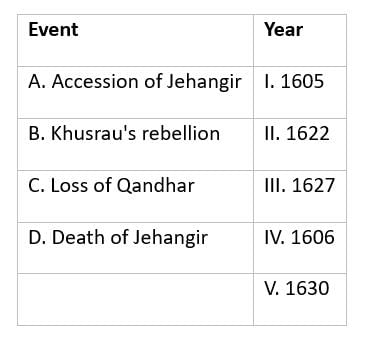UPSC Exam > UPSC Tests > History for UPSC CSE > Satish Chandra Test: Struggle For Empire in North India - UPSC MCQ
Satish Chandra Test: Struggle For Empire in North India - UPSC MCQ
Test Description
10 Questions MCQ Test History for UPSC CSE - Satish Chandra Test: Struggle For Empire in North India
Satish Chandra Test: Struggle For Empire in North India for UPSC 2025 is part of History for UPSC CSE preparation. The Satish Chandra Test: Struggle For Empire in North India questions and answers have been
prepared according to the UPSC exam syllabus.The Satish Chandra Test: Struggle For Empire in North India MCQs are made for UPSC 2025 Exam. Find important
definitions, questions, notes, meanings, examples, exercises, MCQs and online tests for Satish Chandra Test: Struggle For Empire in North India below.
Solutions of Satish Chandra Test: Struggle For Empire in North India questions in English are available as part of our History for UPSC CSE for UPSC & Satish Chandra Test: Struggle For Empire in North India solutions in
Hindi for History for UPSC CSE course. Download more important topics, notes, lectures and mock
test series for UPSC Exam by signing up for free. Attempt Satish Chandra Test: Struggle For Empire in North India | 10 questions in 12 minutes | Mock test for UPSC preparation | Free important questions MCQ to study History for UPSC CSE for UPSC Exam | Download free PDF with solutions
Satish Chandra Test: Struggle For Empire in North India - Question 1
Which of the following is incorrect about Akbar’s mansabdari system?
Detailed Solution for Satish Chandra Test: Struggle For Empire in North India - Question 1
Detailed Solution for Satish Chandra Test: Struggle For Empire in North India - Question 2
Satish Chandra Test: Struggle For Empire in North India - Question 3
Which of the following is correct about the system of escheat under Akbar?
Detailed Solution for Satish Chandra Test: Struggle For Empire in North India - Question 3
Satish Chandra Test: Struggle For Empire in North India - Question 4
Which of the following is incorrect about the institution ofVakil under Akbar?
Detailed Solution for Satish Chandra Test: Struggle For Empire in North India - Question 4
Satish Chandra Test: Struggle For Empire in North India - Question 5
Match the following events with their respective years:

Detailed Solution for Satish Chandra Test: Struggle For Empire in North India - Question 5
Satish Chandra Test: Struggle For Empire in North India - Question 6
Jehangir’s greatest achievement was the signing of a peace treaty with Mewar in 1614. Which was not one of its clauses?
Detailed Solution for Satish Chandra Test: Struggle For Empire in North India - Question 6
Satish Chandra Test: Struggle For Empire in North India - Question 7
Jehangir’s faithful general Mahabat Khan revolted against him in 1626 A.D. because
Detailed Solution for Satish Chandra Test: Struggle For Empire in North India - Question 7
Satish Chandra Test: Struggle For Empire in North India - Question 8
Prince Khurram (Shahjahan) rebelled against Jehangir in 1623 A.D. because of
Detailed Solution for Satish Chandra Test: Struggle For Empire in North India - Question 8
Satish Chandra Test: Struggle For Empire in North India - Question 9
Jehangir was buried at Shahdara near
Detailed Solution for Satish Chandra Test: Struggle For Empire in North India - Question 9
Satish Chandra Test: Struggle For Empire in North India - Question 10
Which of the following events occurred during Shahjahan’s reign?
Detailed Solution for Satish Chandra Test: Struggle For Empire in North India - Question 10
|
210 videos|855 docs|219 tests
|
Information about Satish Chandra Test: Struggle For Empire in North India Page
In this test you can find the Exam questions for Satish Chandra Test: Struggle For Empire in North India solved & explained in the simplest way possible.
Besides giving Questions and answers for Satish Chandra Test: Struggle For Empire in North India, EduRev gives you an ample number of Online tests for practice














